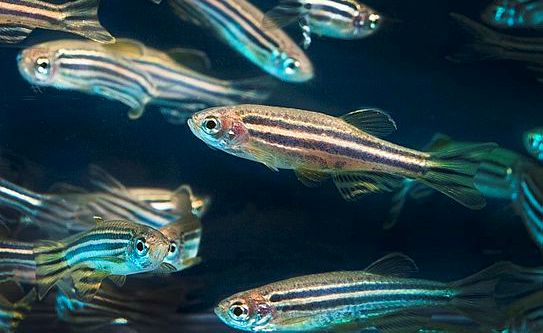The zebrafish is a tiny little fish that has made a huge contribution to science. You might wrongly assume from its name, that a zebrafish would have white and black stripes, but if you have seen a zebrafish, you would know that it has alternating blue and gold stripes. How and why did this little tropical fish come to be such an important part of research?
History
It all started in the early 1970s with the work of, George Streisinger, a researcher in the University of Oregon in the United States of America. He wanted to make “fish” a model to study mutations and genetics and found that Zebrafish (Danio rerio) suited his needs. As his research grew, more and more scientists started using Zebrafish for their own studies, and the rest is history. Today, Zebrafish are widely used across lab around the world for studying everything from the developing nervous system to testing the toxicity of new drugs toxicity.
Zebrafish and Humans
Externally, one might find little in common between this water dwelling fish and humans, but we share many common inherent features such as muscles, hearts, nervous system etc. with Zebrafish. We now know that around 70 percent of the genes that are found in humans have a counterpart in zebrafish, and about 85 percent of genes that cause diseases in humans are found in zebrafish.
Why not use a mouse?
At that time, the most common vertebrate model being used was the mouse, but working with mice isn’t always very easy. There was a need to find a vertebrate model system that was simpler to work with than mice, especially to study the nervous system and Zebrafish proved to be excellent in this study.
It offers one unique feature that mice could not offer- Transparency. Zebrafish embryos are transparent. That means, that just with a simple light microscope, you can clearly see the embryo at every stage of development.
Their embryos develop much faster as compared to humans. After day one, the embryo of the zebrafish develops as much as a human embryo develops after one month. In fact, since the embryo is transparent, you can sit behind a microscope and look at the embryo. Just after 18 hours you will see the fish embryo start to move, and 22 hours later you’ll see the heart beating too. On the other hand, mouse embryos develop inside the mother, and it is not easy to observe their development.
Zebrafish use less space
Adults grow anywhere between 2.5 to 4 cm and they like to live together in “shoals”. In an area where you would keep 75 or 150 mice, you could easily maintain 900 adult zebrafish. Thus, it becomes cheaper to house these fish as compared to mice.
When conducting an experiment, an important factor to remember, is that your results need to be reproducible – this means that when ever you conduct the same experiment again in the lab, you should be able to get the same results, even if you conduct the experiment a hundred miles away in another lab, you should be able to get the same results. To perform such accurate experiments, we need to perform experiments on multiple organisms. A female mouse usually bears 1 to 10 pups at a time and gives birth around 3 times in her life. On the other hand, a zebrafish could release between 100 to 300 embryos every week. The huge number of available embryos proves very useful for large scale testing required for some experiments.
Zebrafish for Testing Toxicity
When discovering new drugs, one important step is to check the safety of the drug. One has to check whether the drug is toxic and if it is, then which organs it affects. Since zebrafish have kidneys, a heart, muscles, blood, bone cartilage, liver pancreas, brain and spinal cord, any ill effect of the new drug would cause a deformity in these organs that could easily be visualized in the transparent embryo. Moreover, the drug to be tested can usually be very easily delivered through the water, from where the embryo would absorb the drug.
Zebrafish for Studying Human Diseases
There are many genetic engineering techniques available that can make this fish develop human diseases. When this is done, it becomes easy to study the cause and effects of the disease. Major research on Muscular Dystrophy has been done through Zebrafish research.
It also showed remarkable property of regeneration in some of its organs. The ability to regenerate its heart tissue has made it an important model in cardiac studies. The zebrafish is also used to study nervous system development, obesity, pigmentation, etc.
Every model organism has its advantages and disadvantages, and each model makes their unique contribution to science. The Zebrafish though comparatively only recently has made its way into the lab, it is now a very important part of research.
Read more Articles from Life Sciences
1. Read about the Start Your Own Fruit Fly Culture at Home
2. Read about the Did You Just Spot a Cheetah a Leopard and a Jaguar
3. Read about the The Secret Lives of Tardigrades
4. Read about the Chlorophyll and Haemoglobin – An Unlikely Connection
5. Read about the What is the True Colour of the Coronavirus?
6. Read about the 7 Fascinating Facts About Fruit Flies
About Author
Saunri Dhodi Lobo is pursuing M.Sc in Life Sciences with specialization in Neurobiology. Her interests include writing poetry, going for nature walks and swimming. Currently she is involved in research on Alzheimer’s Disease in fruit flies.
Read all Articles by Saunri Dhodi Lobo
Photos, Vector Graphics & Illustrations Credits

